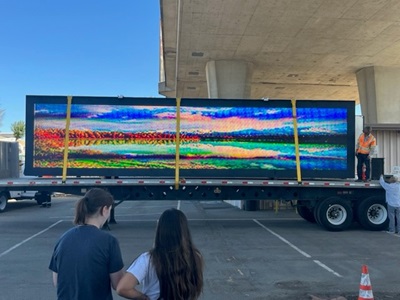
District 10 photo
By Erin McQueary
District 10 public information officer
The future of Changeable Message Signs (CMS) is coming to Caltrans and District 10 will be among the first to pilot this new technology.
The walk-in CMS has full-color, high-resolution LED displays capable of text and graphics. They are also far safer for electrical crews, with a climate-controlled, walk-in space that greatly reduces fall risk and exposure to traffic and inclement weather.
Electrical Maintenance Superintendent Patrick Bayona said the walk-in signs’ most important quality is that they help achieve Caltrans' goal of being a safety-first organization. Instead of standing for hours in a bucket more than 17 feet above ground, crews can walk into the signs and safely shut the door behind them.
Bayona said the walk-in CMS will nearly eliminate the need for costly lane closures and traffic controls during repairs.
District 10 operates 114 CMS, all but eight of which are a model that is now obsolete.
“It just makes sense to put in a newer sign with newer technology; we are futureproofing,” said Omar Mendoza, a senior transportation electrical engineer for Central Region Electrical Design.
Mendoza arranged for two manufacturers of the walk-in signs – Daktronics and Swarco – to showcase their products in Stockton in September 2024.
Since then, District 10 has joined Districts 3, 6, and 11 to pilot the signs in upcoming projects. For District 10, the southbound Stockton Channel Viaduct Bridge Replacement project will include the first walk-in CMS. The project is in the project specification and estimate phase with a ready to list date in 2026, but there is still a lot of work to be done.
A geotechnical study is needed before Structure Design can develop a new structure capable of supporting the weight and dimensions of the walk-in signs. Mendoza and his team will complete the electrical design, then the signs must pass materials testing.
Meanwhile, Intelligent Transportation Systems Operations Branch Chief Arlene Cordero and her team will be working to ensure that new signs can be controlled with existing software.
If the pilot program is successful, Mendoza and Cordero anticipate the district can move forward with replacing CMS signs over time as they reach the end of their 20-year lifecycle.
Cordero said a quarter of D10s CMS are nearing the end of their lifecycle, and most of them have already been planned for replacement in future projects.

